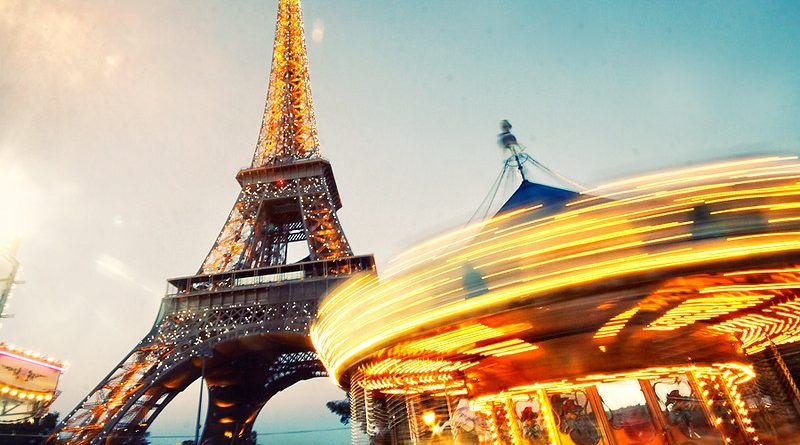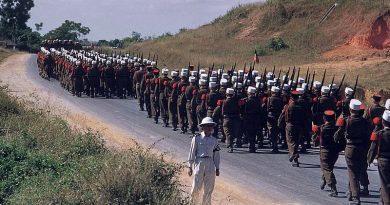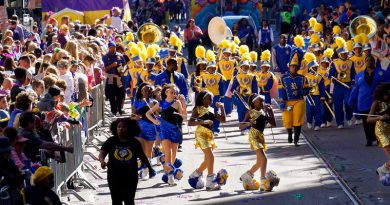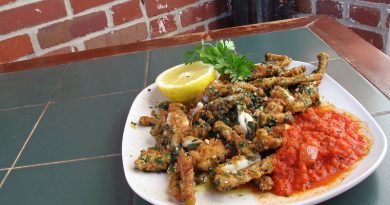The Top 15 Things To See & Do In Paris
The Arc de Triomphe
Located on the right bank of the river, in the middle of 8e Arrandissement are the Champs-Elysees, Arc de Triomphe and some of the city’s most expensive shops. The best view of the Voie Triumphale’s grandiose but simple geometry is from the top of the Arc de Triomphe. Its only from here that you can truly appreciate what the great city planner Baron Hausmann achieved when given the order by Napoleon the third in the 1800’s to create the most beautiful and modern city in the world.
Under Napoleon’s rule the over-crowded lanes of Paris were demolished and replaced with ordered streets and geometrical avenues and boulevards. This was to become a blueprint for future town planning all over the world. Your attention however is most likely to be caught not by the view but by the mesmerizing traffic directly below you, around the massive place Charles-de-Gaulle, better known as “Place de l’Etoile“. This is the world’s first organized roundabout. Twelve wide avenues make up the star or the Etoile, of which the busiest is the Champs-Elysees.
L’Opera
The Place de la Bastille is an important symbol of revolt as this is where the French revolution started. This area is considered to be one of the more working class in Paris, which is why Francois Mitterand decided to build his opera house for the people in this spot. However, the Opera House is one of the more controversial of the ‘grande project’, both for its cost over-runs, its design, and for the simple fact that most of the people living ocally can’t even afford the tickets.
The Louvre
Situated at the start of the Voie Triomphale on the right bank is Paris’s largest monument – The Palace of Louvre. The Louvre has been a fortress, an arsenal, a prison and a royal palace. It was begun by Philippe-Auguste in 1200 as a fortress to store his scrolls, jewels and swords while he himself lived on the Ile de la Cite. Charles V was the first French King to make the castle his residence, but not until Francois I in the mid-sixteenth century were the beginnings of the palace laid and the fortress demolished. In 1793, after the French revolution, it became a public museum, and art was available to the masses. Every alteration and addition up to 1988 created a surprisingly homogeneous building, with a grandeur, symmetry and French ness entirely suited t this most historic of Parisian edifices.
The Louvre contains one of the most important art collections in the world. As it’s so huge it is divided into different wings, which are all colour coded and labelled. The Pyramide is the main entrance to the Musee du Louvre, although alternative access directly from the metro, the porte des Lions, the Arc du Carrouysel or from rue de Rivoli allows you to avoid the queue here. Tickets can be bought in the Hall Napoleon, below the Pyramide and at the Porte des Lions entrance.
The Musee de Louvre is divided into seven basic categories: Oriental antiquities, Egyptian antiquities, Greek, Etruscan and Roman antiques, Sculpture, Objects d’Arts, Painting; and Prints, and Drawings. The painting section also houses the Mona Lisa (Denon, first floor, room 6). To have a good look at the famous painting, you will need to go first or last thing in the day. For a less hurried inspection of Leonardo da Vinci’s art, have a look at his Virgin of the Rocks andVirgin and Child with St Anne, on display in the Grande Galerie.
Apart from the Musee du Louvre, the Louvre palace houses three other museums in its northern wing. The entrance to the Musee de la Mode et du Textile, the Musee des Arts Decoratifs and the Musee de la Publicite can be found at 107 rue de Rivoli, where a combined ticket for the three can be purchased.
Nevertheless, it’s easy to loose your way here. The Louvre may be the most avoided museum in Paris. Tourists, daunted by the sheer size and richness of the place often find the smaller museums much more inviting. But eventually most people do their duty and come, and most leave – overwhelmed and exhausted.
If you’re planning to visit many museums in a short time it is advisable to buy a Carte Musees et Monuments pass from the tourist office or the RER or metro stations. It is valid for 70 museums and monuments in a around Paris and allows you to bypass the long queues. Many museums offer discounts to certain age groups and to students.
Notre-Dame
The River Seine flows in an arc through the middle from east to west, around its two islands called the Ile de la Cite and Ile St-Louis. It is at Ile de la Cite, where Notre Dame sits at the historic heart of the capital.
Described as the greatest masterpiece of the Middle Ages, Notre Dame is truly impressive, especially the great H-shaped west front, with its strong vertical divisions counterbalanced by the horizontal emphasis of gallery and frieze, all centered on a rose window. It’s a solid design, confessing its Romanesque ancestry. For more fantastical Gothic, look rather at the north transept façade with its croqueted gables and huge fretted window space.
The most striking feature inside the cathedral is the dramatic contrast between the darkness of the nave and the light falling on the first great clustered pillars of the choir, emphasizing the special nature of the sanctuary. It is the end walls of the transept that admit all its light, nearly two thirds glass, including two magnificent rose windows coloured in imperial purple.
The monument is so popular that there are long queues out onto the square. The whole scene can get uncomfortably crowded, and the immediate area is crammed with souvenir shops. On the fun side, there is always a bunch of spectators jostling for a view of the young roller-bladers going through their gymnastic stunts just outside the cathedral on the Pont au Double.
Le Grand Arc de Defense
Francois Mitterand, the President of France for fourteen years, wanted the world to remember his reign and he did that by commissioning a number of ‘grande projects’. These were large architectural projects and the Grande Arc de la Defense was one of them. The whole idea behind the big arch was that it would line up with the arch of the Arc de Triomphe, but the project didn’t go as planned and it was designed on a different angle, so it doesn’t line up with the Arc de Triomphe at all. Le Grand Arc de la Defense was completed in 1989 for the bicentennial of the French revolution. Since then it has become a major tourist attraction, particularly for its views from the top.
Bibliotheque Nationale
Beyond the street from Palais Royal is the forbidding wall of the old Bibliotheque Nationale or the national library. It is a set of four buildings in the shape of open books. This was the last ‘grande project’ that Mitterand made before he died in 1996. Some people call it a monument to one man’s ego, but it definitely is a site to visit. You can enter free of charge and peer into the atmospheric reading rooms or pay to enter the various exhibitions.
There are over ten millions books in Bibliotheque Nationale. However the library itself doesn’t seem to be made for books or for that matter, people. The books are kept in separate tall glass towers. Public entry moreover is confined to the ground floor.
The Eiffel Tower
The vistas across the river between the 7e arrandissement south of the river and the 8e and 16e on the north of the river are impressive, particularly in the night. One of the best viewpoints to appreciate these areas is from the Eiffel tower, a structure that lies close to the centre.
When completed in 1889, the Eiffel Tower was the tallest building in the world at 1000ft, and weighing a mighty 7000 tones of steel. It stole the show at the 1889 Exposition, for which it had been constructed. In the 1980’s the tower was given a new system of illumination from within its superstructure, so that it now looks as its magical best after dark, as lighten and fanciful as a filigree minaret.
Going to the top costs around 10 euros by lift, or you can go by stairs for the first two level and by lift for the final level for around 6 euros. All in all it’s worth the experience on a clear day.
Sacre-Coeur
In the north of Paris, crowing the butte, is the Sacre-Coeur. It actually is a romantic and graceful pastiche, whose white pimpy domes are an essential part of the Paris skyline. The best thing about it is the view from the tower, almost as high as the Eiffel Tower and showing the layout of the whole city. Construction was started in the 1870’s on the initiative of the Catholic Church to atone for the “crimes” of the Commune. Square Willette, the space at the foot of the monumental staircase, is named after the local artist who turned out on inauguration day to shout, “Long live the devil!”
The Marais
On the right bank of the river lies the Marais, one of the trendiest places in Paris, with great places to eat. It was not until the sixteen and seventeen centuries that the Marais, the area between Beaubourg and the Bastille became a fashionable aristocratic district.
Though cornered by Haussmann’s boulevards, the Marais itself was spared the baron’s heavy touch, and very little has been pulled down in the recent gentrification. This is Paris’s most seductive, secluded, safe area. It has many alluring shops, bars and places to eat. It’s very tempting walking along the street with all the smells coming out of the stores and the pastries shops. It is here that one can see a lively combination of orthodox Jews, a strong gay community, lots of artists and little galleries.
The Riverside
The riverside part of the 6e arrandissement is cut lengthwise by Rue St-Andre-des Arts andRue Jacob. It is full of bookshops, commercial art galleries, antique shops, cafes and restaurants. If you happen to poke your nose into the country yards and side streets, you’ll find foliage, fountains and peaceful enclaves removed from the bustle of the city.
Jardin de Luxembourg
To the south of Rue Ferou, on the left bank of the river, is the Palais du Luxembourg. The Palais was constructed for Marie de Medicis, Henri IV’s widow to remind her of her native Florence. Today it is the seat of the French Senate and its gardens are the chief recreation ground, with tennis courts, pony rides, children’s play grounds, boules pitch and yachts to rent on the pond. In the wilder southeast corner lies a miniature orchard of elaborately espaliered pear trees. It is the most popular park in whole of Paris. The sixty acres that are located around the Luxembourg Paris provide a quiet retreat for the many Parisians who don’t have gardens.
Avenue Montaigne
The Avenue Montaigne is the heartland of haute couture. It’s a designer heaven, and a must for fashion conscious travellers who visit Paris. Most of the shops here are expensive and for more affordable prices you can try the discount store, Tati.
Top sites outside the City:
Disneyland
Situated about fifteen miles east of the city is Disneyland Paris. It is one of the biggest tourist attractions, not only in France but also in all of Europe and around twelve million people visit it every year – that’s more than the entire population of Paris. For travellers, Disneyland Paris can sometimes be a good place to find temporary work.
When Disneyland first opened in 1992 it was received with considerable horror. Many French saw it as a threat to their culture; electricity pylons supplying the site were blown up, transport workers went on strike, and Disneyland Paris shares plummeted. Then in about 1996 French management took over and overhauled the park. Entry fees were dropped, and it was then that busloads started rolling in.
Since the opening to the Space Mountain, Disneyland Paris has provided a variety of good fear-and-thrill rides, though the majority of attractions remain very safe and staid. All the structures are incredibly detailed and their shades and textures are worked out with precision. There are no primary colours in this park; all of it is only pastel. The Magic Kingdom is divided into four lands radiating out from Main Street USA. The Fantasyland, with Sleeping Beauty Castle, Peter Pan’s Flight, Dumbo the flying elephant and mad hatter’s teacups, appeals to the youngest kids. Adventureland on the other hand has more outlandish sets. It also has two of the best rides – ‘Pirates of the Caribbean’ and ‘Indiana Jones and the temple of Doom’. Frontier has the psycho-inspired but inspired Phantom Manor and the hair-rising roller coaster ‘Big Thunder Mountain’. In Discoveryland there’s a high-tech 3-D experience called “Honey I shrunk the audience”! Night time electrical parades and firework displays take place several times a week. Besides the theme park the complex includes Festival Disney, the evening entertainment centre where you can watch the Buffalo Bill’s Wild West show with real guns, horses, bulls and bison.
To reach Disneyland from Paris it is best to take RER line A to Marne-la-Vallee. However if you wish to reach Disneyland straight from the airport, then you can take a shuttle bus from both Charles-de-Gaulle and Orly. If you are driving, follow the A4 East for twenty miles.
Fontainebleau
Fontainebleau is famous for its vast, rambling chateau. From Gare de Lyon is Paris it is a mere 50-minute train ride to Fontainebleau. The Chateau owes its existence to its situation in the middle of a magnificent forest, which made it the perfect base for royal hunting expeditions. A hunting lodge was built here as early as the twelfth century, but it only began its transformation into a luxurious palace during the sixteenth century. This was done on the initiative of Francois 1er, who imported a colony of Italian artists to carry out the decoration. The gardens around the chateau are equally luscious, but if you want to escape to the relative wilds, then the surrounding forest of Fontainebleau is full of walking and cycling trails.
Versailles
 The Palace of Versailles is one of the most visited monuments in France. The palace was inspired by the young Louis XIV’s envy of his finance minister’s chateau at Vaux-le-Vicomte. Apart from a few areas you can visit in your own, most of the place can be viewed in guided groups whose various itineraries can be booked in the morning at entrance D. Of the rooms you can visit without a guide, the most stunning and dazzling is the Galerie des Glaces or the Hall of Mirrors where the Treaty of Versailles was signed to end World War I. To get to the chateau, take the 40-minute ride in the RER line C5 to Versailles-Rive Gauche.
The Palace of Versailles is one of the most visited monuments in France. The palace was inspired by the young Louis XIV’s envy of his finance minister’s chateau at Vaux-le-Vicomte. Apart from a few areas you can visit in your own, most of the place can be viewed in guided groups whose various itineraries can be booked in the morning at entrance D. Of the rooms you can visit without a guide, the most stunning and dazzling is the Galerie des Glaces or the Hall of Mirrors where the Treaty of Versailles was signed to end World War I. To get to the chateau, take the 40-minute ride in the RER line C5 to Versailles-Rive Gauche.




